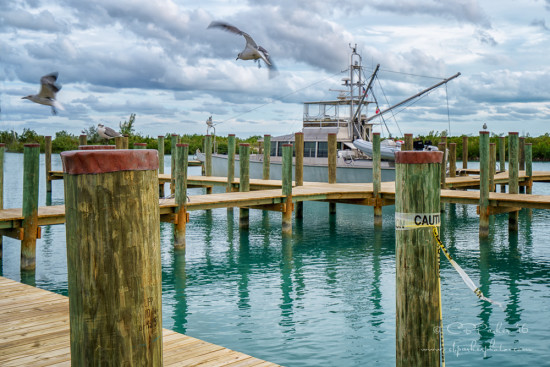We’re doing some real live cruising again, heading south towards warmer weather and blue water. Yesterday we caught a mahi mahi trolling from AVATAR’s stern, which was transformed by May into lunch within the hour. Afterwards we plunged into the sea for our first saltwater swim in more than a year. It feels great to be bluewater cruising again!
Mike and I joined Rod and May aboard AVATAR in Palm Beach a little more than a week ago, and the following day we headed south across the Gulf Stream to the Bahamas. This voyage we plan to island hop through the Bahamas until we reach the Turks and Caicos, fly home from there and return for a second Caribbean tour later in the spring.
The weather has been a bit on the wintry side, although nothing like we’ve been reading about in the US with its Arctic chill. Still, our first arrival was in 40 knot wind gusts, sideways blowing rain, and white capped waves. We had to linger outside the harbor entrance until things died down a bit. Thus far we have had primarily overcast skies, a few more squalls, and temperatures in the low 70’s which feels a bit chilly in wind and no sunshine. It is only when the sun comes out that the sea here turns myriad shades of astonishing blues and turquoises.
With persistent windy conditions in the forecast, we’ve been hiding out in marinas for security, not wanting to anchor out in a blow of 30 knots. Our longest layover so far was in Hopetown on Elbow Cay in the Abacos. This was an inviting and entertaining spot with a first rate marina and facilities, rental golf carts for touring the island, and free rides in the resort launch across the harbor to the quaint and charming town and adjacent swimming beach with a long stretch of inviting sand and a gentle turquoise surf rolling on to shore.
A major attraction during our stay was the red and white striped Elbow Reef Lighthouse, just a short walk from our berth. 150 years old, this working lighthouse is the last remaining kerosene powered one in the world. It was built in spite of strong local opposition from a populace that had been profiting from a lucrative occupation luring ships onto the reef and salvaging the contents of the resulting wrecks. It took quite a long time to complete construction of the tower as repeated vandalism by its foes slowed progress.
Now, of course, the lighthouse is the pride of the island. It is open to visit, free of charge, seven days a week. And by request, the lighthouse keeper will allow visitors to come after hours to observe the lighting of the lamp shortly after sunset. This is a lengthy process that requires a period of slow heating before the light finally catches fire and begins to illuminate, eventually revolving slowly as it casts its beam out to sea, warning ships away from the dangerous rocky coast. Another unusual job requirement for the lighthouse keeper is the task of winding up the mechanism every two hours, day and night, a process that has been going on without fail for the past 150 years of the lighthouse’s existence.
We visited the lighthouse three times – the first was the requisite tourist tour by day, climbing the spiraling tower stairs and taking in the spectacular view from the top. We returned the next evening to observe and photograph the lighting process, and a third visit the following night with a change of camera lenses with the goal of photographing the lighthouse beaming its rays into the night.
Click on any image below for a full screen slideshow:
